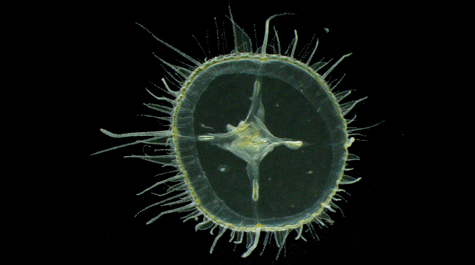The Craspedacusta are swarming in Crim Dell, and that means the jellyfish are looking for mates
Yes, they have stinging tentacles. No, they won’t sting you — unless you’re a tasty-looking zooplankton.
Jellyfish are swarming in the pond at Crim Dell. Jon Allen tweeted out the news shortly after 5 p.m. on Sept. 18.
“Just when you thought it was safe to go back in the water… the Crim Jellies are back!” began the tweet from @AllenLabWM. It went on to tag @williamandmary and @STEM_at_WM, thereby creating a modest ripple in the William & Mary Twitterverse.
Allen is an associate professor in the Department of Biology at William & Mary. He specializes in marine invertebrates and his lab has a rotating roster of jellies, sea stars and other oceanic creatures. Members of his Biology 457 class, Marine Invertebrate Biology, captured a few specimens of the Crim jellies on Thursday.
But the Crim Jellies are not, strictly speaking, marine invertebrates. They’re freshwater jellyfish, only distantly related to the more familiar and sting-y Portuguese man of war and the sea nettle. The Allen Lab was being jocular in its tweet: Swimming is not encouraged in Crim Dell, but it’s not because the jellyfish will get you.
“The jellies eat mosquito larvae, so they actually provide a service to the campus in keeping the population of biting insects at bay,” Allen noted.
And it’s not quite the case that the “Crim Jellies are back,” as they’ve been here for some time. Craspedacusta jellyfish are an invasive species, native to China. There’s nothing unusual about them being in Crim Dell, either.
“The last time they were documented in the Crim Dell is 2010 when there was a large swarm of them,” Allen said. "That summer there were also jelly blooms in other parts of the state as well.”
Freshwater jellies have become common in freshwater ponds and lakes in North America. You just don’t notice them. In fact, they’re pretty easy to miss.
“They’re pretty small — about the diameter of a dime," Allen said. “I’ve seen some closer to a quarter in size, but that is as big as they get. So they are visible with the naked eye, but not obvious unless you are looking for them.”
The most visible stage of any jellyfish is the tentacled adult form, known as the medusa. Allen explains that the little creatures usually hang around the bottom, progressing from a larval stage, known as a planula, to a polyp.
Polyps, Allen said, reproduce asexually. But some of the polyps become medusae. Fall brings the medusae up near the surface in blooms that are hard to predict. Jellyfish might suddenly show up in bodies of water where no Craspedacusta have been seen before. Allen said the business of a mature Craspedacusta medusa is reproduction, sexual reproduction. But there’s a catch.
“Usually the medusae are all of one sex — all male or all female — and so the goal of sexual reproduction is almost certainly not achieved,” Allen said. “Though I suppose that doesn’t necessarily mean that the love the jellies may feel is unrequited.”
 Skip to main content
Skip to main content

